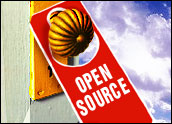
Government entities around the world are not only increasing their use of free and open source software (FOSS), they are actually sharing, collaborating and coordinating in open source fashion to meet federal, state and local government IT needs, recent data suggests.
IDC’s government IT research company Government Insights predicts open source software will gain momentum faster in the government sector than in any other market segment over the next five to ten years, earning a 30 percent compound annual growth rate through 2009.
“It’s not a totally new trend because there has always been sharing of programs and components at some level, but interest seems to be picking up substantially,” Shawn McCarthy, head of vendor programs for Government Insights, told LinuxInsider.
Ideal for Open Source
Open source use among government entities is likely to become as aggressive as many IT departments’ adoption of Linux was in its early days, when the operating system first stormed the server market in the mid-1990s.
McCarthy explained: “Government has a unique opportunity to lead the way for three reasons: first, cooperation between state governments can help them build software solutions that can be shared by multiple states; second, there is pressure on states to reduce costs, improve service to citizens, and standardize operations, and developing open software platforms is a way to do this; and third, large IT services companies have shown they are willing to invest their own money in certain open solutions so that they can influence the standard and assure that they have powerful, open products which can be used when they sell their services and solutions to the government.”
Vendors Responding
Governments that help coordinate open source development benefit from the code created in this fashion because the resulting software bolsters their service to citizens, McCarthy noted.
“State governments in particular will benefit from the approach of keeping software value within a community,” he said. “An application created for one state can easily be used by other states.”
The Government Insights findings also reflect a response to government needs for open code from top open source software and support vendors, including IBM, which has put substantial investment into Trusted Linux, according to McCarthy.
Trusted Linux, also supported by Red Hat and Trusted Computing Solutions, is based on the Linux kernel and the Security Enhanced Linux (SELinux) operating system from the National Security Agency.
“This is a model which I expect will be followed as other types of open government applications are developed,” McCarthy said. “There is interest in fledgling solutions, but none have reached critical mass yet. [However], Linux has proven that such critical mass can be achieved with the right motivation.”
Smaller Fear Factor
After years of buildup, open source software, as well as open standards, are on a significant upswing in the government sector, as larger numbers of individuals and entities have gotten on board with the technology, Open Source and Industry Alliance (OSAIA) Director of Public Policy Will Rodger told LinuxInsider.
“There’s no question open source, and open technologies in general, are really taking off like wildfire in the government sector right now,” he said. “It’s doing so in large part because of what’s become a critical mass of activity over the last five years.”
As a result, governments are now more willing to disclose and discuss their open technology plans and products because they are less fearful of agency infighting or pressure from vendors of proprietary software, Rodger said.
“People are simply realizing they can share information without the fear of retribution they felt a few years ago,” he said.
Remarkable Sharing, Robustness
Though vendor response to open technology demand in government has been strong, McCarthy stressed the need for improved systems stability in order to ensure that government bodies will indeed benefit from open source savings.
“It is the large IT services vendors who have an opportunity to help drive the development of open source applications,” he said. “The service providers and the government could save on application licensing costs in the long run, but only if the applications can be made robust enough.”



















































Firstly the people involved in SE Linux development generally prefer to avoid the term "Trusted Linux". The proprietary "Trusted Unix" OSs have a bad reputation for being difficult to use, expensive, and poorly supported by applications.
SE Linux is a core feature in Red Hat distributions and is being included in Debian and Gentoo. This makes it popular enough to have a good level of community knowledge and application support. Thus it won’t fail in the market as the "Trusted Unix" products did.
SE Linux is not an "operating system", it is a mandatory access control system for Linux comprising a kernel patch to enforce access control and a set of patches to a number of applications and utilities. All the relevant code has been accepted by upstream repositories such as kernel.org – SE Linux is a standard Linux feature.